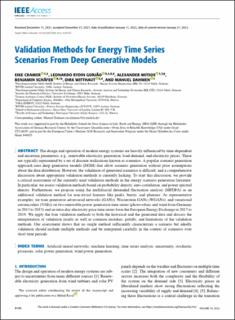| dc.contributor.author | Cramer, Eike | |
| dc.contributor.author | Rydin Gorjao, Leonardo | |
| dc.contributor.author | Mitsos, Alexander | |
| dc.contributor.author | Schäfer, Benjamin | |
| dc.contributor.author | Witthaut, Dirk | |
| dc.contributor.author | Dahmen, Manuel | |
| dc.date.accessioned | 2023-02-20T09:59:48Z | |
| dc.date.available | 2023-02-20T09:59:48Z | |
| dc.date.created | 2022-05-19T14:12:56Z | |
| dc.date.issued | 2022-01-11 | |
| dc.identifier.citation | IEEE Access. 2022, 10 8194-8207. | en_US |
| dc.identifier.issn | 2169-3536 | |
| dc.identifier.uri | https://hdl.handle.net/11250/3052254 | |
| dc.description.abstract | The design and operation of modern energy systems are heavily influenced by time-dependent and uncertain parameters, e.g., renewable electricity generation, load-demand, and electricity prices. These are typically represented by a set of discrete realizations known as scenarios. A popular scenario generation approach uses deep generative models (DGM) that allow scenario generation without prior assumptions about the data distribution. However, the validation of generated scenarios is difficult, and a comprehensive discussion about appropriate validation methods is currently lacking. To start this discussion, we provide a critical assessment of the currently used validation methods in the energy scenario generation literature. In particular, we assess validation methods based on probability density, auto-correlation, and power spectral density. Furthermore, we propose using the multifractal detrended fluctuation analysis (MFDFA) as an additional validation method for non-trivial features like peaks, bursts, and plateaus. As representative examples, we train generative adversarial networks (GANs), Wasserstein GANs (WGANs), and variational autoencoders (VAEs) on two renewable power generation time series (photovoltaic and wind from Germany in 2013 to 2015) and an intra-day electricity price time series form the European Energy Exchange in 2017 to 2019. We apply the four validation methods to both the historical and the generated data and discuss the interpretation of validation results as well as common mistakes, pitfalls, and limitations of the validation methods. Our assessment shows that no single method sufficiently characterizes a scenario but ideally validation should include multiple methods and be interpreted carefully in the context of scenarios over short time periods. | en_US |
| dc.language.iso | eng | en_US |
| dc.publisher | Institute of Electrical and Electronics Engineers (IEEE) | en_US |
| dc.relation.ispartofseries | IEEE Access;Volume: 10 | |
| dc.rights | Navngivelse 4.0 Internasjonal | * |
| dc.rights.uri | http://creativecommons.org/licenses/by/4.0/deed.no | * |
| dc.title | Validation Methods for Energy Time Series Scenarios From Deep Generative Models | en_US |
| dc.title.alternative | Validation Methods for Energy Time Series Scenarios From Deep Generative Models | en_US |
| dc.type | Peer reviewed | en_US |
| dc.type | Journal article | en_US |
| dc.description.version | publishedVersion | en_US |
| cristin.ispublished | true | |
| cristin.fulltext | original | |
| cristin.qualitycode | 1 | |
| dc.identifier.doi | https://doi.org/10.1109/ACCESS.2022.3141875 | |
| dc.identifier.cristin | 2025697 | |
| dc.source.journal | IEEE Access | en_US |
| dc.source.volume | 10 | en_US |
| dc.source.issue | 10 | en_US |
| dc.source.pagenumber | 8194-8207 | en_US |

